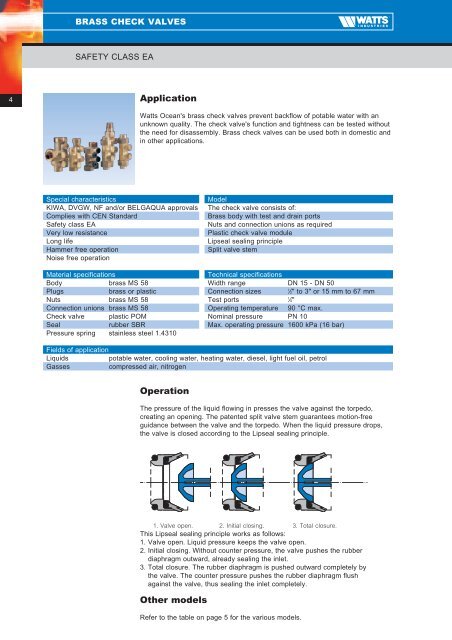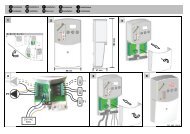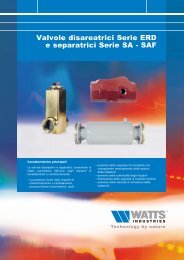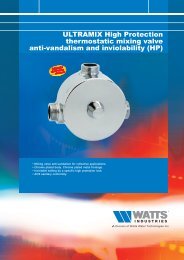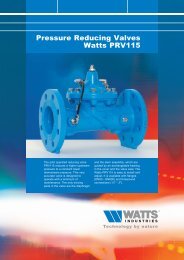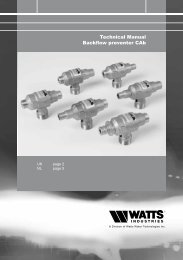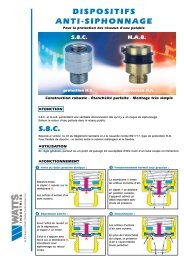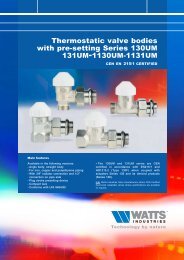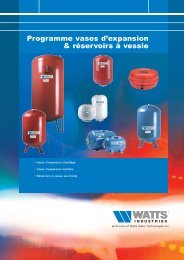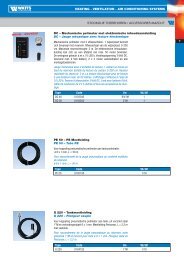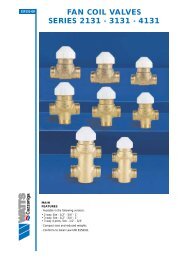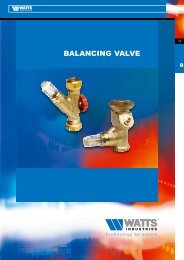Brass Check Valves - Watts Industries
Brass Check Valves - Watts Industries
Brass Check Valves - Watts Industries
Create successful ePaper yourself
Turn your PDF publications into a flip-book with our unique Google optimized e-Paper software.
BRASS CHECK VALVES<br />
SAFETY CLASS EA<br />
4<br />
Application<br />
<strong>Watts</strong> Ocean's brass check valves prevent backflow of potable water with an<br />
unknown quality. The check valve's function and tightness can be tested without<br />
the need for disassembly. <strong>Brass</strong> check valves can be used both in domestic and<br />
in other applications.<br />
Special characteristics<br />
KIWA, DVGW, NF and/or BELGAQUA approvals<br />
Complies with CEN Standard<br />
Safety class EA<br />
Very low resistance<br />
Long life<br />
Hammer free operation<br />
Noise free operation<br />
Material specifications<br />
Body brass MS 58<br />
Plugs<br />
brass or plastic<br />
Nuts brass MS 58<br />
Connection unions brass MS 58<br />
<strong>Check</strong> valve plastic POM<br />
Seal<br />
rubber SBR<br />
Pressure spring stainless steel 1.4310<br />
Model<br />
The check valve consists of:<br />
<strong>Brass</strong> body with test and drain ports<br />
Nuts and connection unions as required<br />
Plastic check valve module<br />
Lipseal sealing principle<br />
Split valve stem<br />
Technical specifications<br />
Width range DN 15 - DN 50<br />
Connection sizes<br />
1<br />
⁄2" to 3" or 15 mm to 67 mm<br />
Test ports 1<br />
⁄4"<br />
Operating temperature 90 °C max.<br />
Nominal pressure PN 10<br />
Max. operating pressure 1600 kPa (16 bar)<br />
Fields of application<br />
Liquids<br />
potable water, cooling water, heating water, diesel, light fuel oil, petrol<br />
Gasses<br />
compressed air, nitrogen<br />
Operation<br />
The pressure of the liquid flowing in presses the valve against the torpedo,<br />
creating an opening. The patented split valve stem guarantees motion-free<br />
guidance between the valve and the torpedo. When the liquid pressure drops,<br />
the valve is closed according to the Lipseal sealing principle.<br />
1. Valve open. 2. Initial closing. 3. Total closure.<br />
This Lipseal sealing principle works as follows:<br />
1. Valve open. Liquid pressure keeps the valve open.<br />
2. Initial closing. Without counter pressure, the valve pushes the rubber<br />
diaphragm outward, already sealing the inlet.<br />
3. Total closure. The rubber diaphragm is pushed outward completely by<br />
the valve. The counter pressure pushes the rubber diaphragm flush<br />
against the valve, thus sealing the inlet completely.<br />
Other models<br />
Refer to the table on page 5 for the various models.


